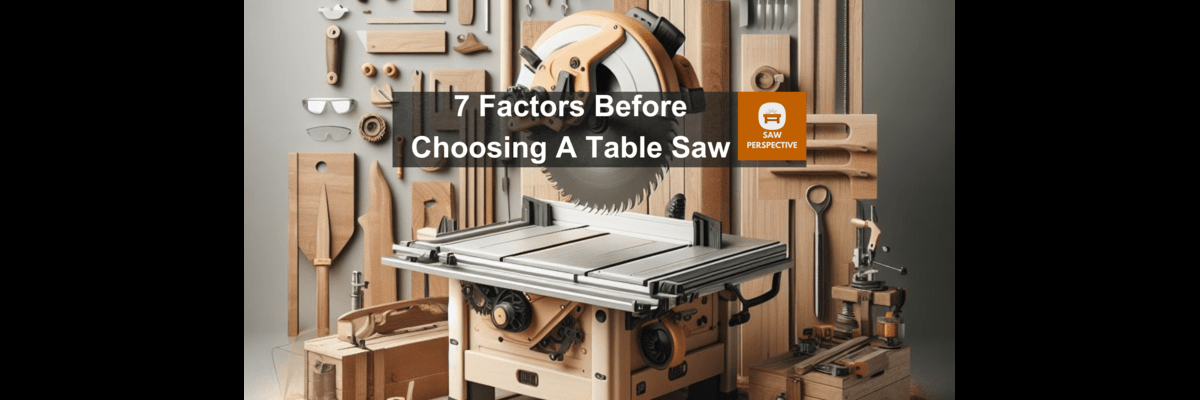A table saw is an essential tool for any woodworker. It offers precise cuts and versatility for a wide range of projects. It’s great for furniture building and carpentry. But with so many models on the market, choosing the right one can be daunting.
This guide will explore seven key factors to consider. It will help you find the table saw that perfectly complements your skill level. It will also help you find the saw that fits your project needs.

1. Features Of The Table Saw
- Rip and crosscut capabilities
- Adjustable blade height and tilt
- Rip fence
- Miter gauge
- Safety features
- Dust collection port
- Motor power
- Table size
- Portability
- Specially Features
2. Specifications Of The Table Saw
- Motor: 15 amp, 120-volt
- Blade: 10 inches
- Rip capacity: 30 inches
- Depth of cut: 3 inches
- Miter gauge: Yes
- Rip fence: Yes
- Dust collection port: Yes
- Weight: 150 pounds
3. Precision
The precision of a table saw is a critical factor. It influences its performance across various applications. Precision in a table saw refers to the tool’s ability to make accurate and consistent cuts.
1. Straight Cuts: People use table saws to make rip cuts, which involve cutting wood parallel to the grain. Precision in straight cuts is crucial for creating uniform pieces. This is important for applications like building furniture or cabinetry.
2. Cross Cuts: When making cross cuts, which involve cutting wood perpendicular to the grain. The precision ensures clean and square edges. This is vital for tasks such as creating accurate joints or sizing wood pieces for assembly.
3. Miter Cuts: Precision is essential for creating precise angles in miter cuts. Miter cuts are used in projects like framing, molding, or constructing picture frames. Accurate miter cuts contribute to tight joints and seamless connections.
4. Dado Cuts: Some table saws are equipped with features for making dado cuts. These cuts involve creating wide grooves to join wood pieces together. Precision in dado cuts ensures a snug fit for the pieces. This enhances the strength and stability of the final construction.
5. Bevel Cuts:
Table saws with tilting arbor mechanisms can make bevel cuts. The blade tilts to create angled edges. Precision in bevel cuts is crucial for tasks like chamfering. It is also crucial for creating beveled edges for aesthetic purposes.
6. Repeatable Accuracy:
Precision is not a one-time need; it’s about achieving consistent and repeatable accuracy. This is especially important for batch production. It is also important when creating many pieces that need to fit together.
7. Material Versatility: A table saw’s precision isn’t limited to wood. It also applies to plastics and laminates. The tool can cut different materials, making it more useful.
8. Fence and Guide Systems: The design and quality of the fence and guide systems play a crucial role in achieving precision. A sturdy, adjustable fence holds the workpiece. It maintains a consistent position during cuts.
9. Blade Quality and Alignment: The precision of a table saw depends on the quality and alignment of the blade. A sharp and well-aligned blade minimizes deflection.
10. User Skill and Experience: A high-precision table saw is essential. The operator’s skill and experience also contribute to achieving accurate cuts. Proper setup, calibration, and adherence to safety practices further enhance the tool’s precision.
4. Accuracy
A table saw must be accurate to make precise, high-quality cuts in woodworking. Precision is essential when using a table saw. It ensures seamless joints, accurate measurements, and a professional finish.
1. Alignment and Calibration: Ensuring that the table saw is aligned and calibrated is fundamental. Ensure precise alignment of the blade, fence, miter gauge, and other components. This will help them perform.
2. Quality of the Blade: The type and quality of the saw blade play a crucial role in the accuracy of cuts. A sharp, well-maintained blade with the appropriate tooth configuration.
3.Fence Quality and Alignment: The fence is a critical component for making straight and parallel cuts. It should be sturdy, straight, and easy to adjust.
4. Miter Gauge Accuracy: The miter gauge is used for making angled cuts. It should slide in its slot. It should have a positive locking mechanism to ensure that the angles are set accurately.
5. Anti-Kickback Mechanism: Many modern table saws come with anti-kickback mechanisms. These features help prevent the material from being thrown back towards the operator during a cut.
6. Dust Collection: Dust and debris around the cutting area can affect the accuracy of cuts. Effective dust collection systems help maintain a clean workspace.
7. Material Support and Stability: Effective material support enhances the stability when handling large and heavy workpieces. This support comes in the form of extension tables or roller stands.
8. Operator Skill and Technique: The operator’s skill and technique also impact achieving precise cuts. Proper feeding of the material, maintaining steady pressure.
5. Portability vs Stability
| Feature | Portability | Stability |
| Definition | Ease of movement and setup | Resistance to wobbling and vibration |
| Importance | deal for job sites, limited workspace, and occasional use | Crucial for accurate cuts, larger projects, and heavy-duty use |
| Advantages | Easy to transport and store | Provides accurate cuts |
| Disadvantages | May sacrifice stability | Less mobile and heavier |
| Ideal for | DIYers, hobbyists, infrequent use, job sites | Woodworkers, professionals, large projects, heavy-duty use |
6. Safety Features
1. Blade guard
2. Anti-kickback pawls
3. Riving knife
4. Blade brake
5. Push stick
6. On/off switch with emergency shut-off
7. Adjustable blade height and angle
8. Splitters
9. Fence system
10. Overload protection
7. Budget Considerations
Basic DIY and Home Use: For occasional DIY projects and basic woodworking tasks at home, a contractor table saw with a smaller motor (1-1.5 HP) may suffice. These can range from $200 to $500.
Intermediate Woodworking: If you’re involved in more intermediate woodworking projects and must a higher level of precision. Consider a mid-range contractor or hybrid table saw. Prices for these saws can range from $500 to $1,500.
Professional Woodworking: Professional woodworkers or those tackling larger projects may need the power and precision of a cabinet table saw.
Cabinet table saws with 3 HP motors or more can start around $1,500 and go well beyond $3,000. These saws often have larger tables and robust construction. They also have advanced features for fine woodworking.
Jobsite Portability: If you need a table saw for on-site work, a portable or jobsite table saw is a good choice. These typically have smaller tables, are lightweight, and can be easily transported.
Prices for quality portable table saws can range from $300 to $800. Consider features like a folding stand, durability, and ease of setup.
Specialized Applications:
A table saw with extended tables or a sliding table attachment might be necessary. Sliding table saws or those with sliding attachments can be more expensive. It ranges from $1,000 to $5,000 or more depending on the features and brand.
Safety Features: Table saws are equipped with advanced safety features. These include flesh-detection technology or electronic brake systems. Investing in safety is crucial. Saws with these features can cost from $1,000 to $3,000 or more.
Brand Reputation: Established brands have a history of producing reliable and durable tools. They may have higher-priced models. However, the investment often pays off in terms of build quality and customer support.
Types Of Table Saws To Choose As Per Your Needs
Following are the types of table saw :
- Cabinet Table Saw
- Contractor Table Saw
- Hybrid Table Saw
- Benchtop Table Saw
- Portable Table Saw
- Specialty Table Saw

